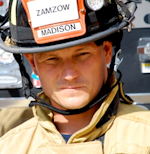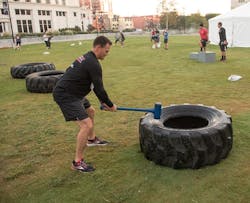Health & Wellness: The Five Best Ways to Improve Firefighter Stamina
To ensure that you, as a first responder, are ready to handle the long days and long calls, you must understand the basics of stamina and how to improve it. Many might equate “stamina” with “endurance.” It’s important to note that there is a difference, particularly in the context of the fireground.
Stamina is the mental and physical ability to sustain an activity for a long period, such as a fireground operation: searching, fire attack, overhaul, etc. Endurance refers to your body’s physical capability to sustain a single exercise for an extended period, such as walking up steps or swinging a sledge. They are remarkably similar, but stamina encompasses more skill and mental focus, which is why it’s so crucial for firefighters to work to improve it.
Increased stamina means reduced fatigue, less energy required to complete a task, and better physical and mental health and well-being. Here are five ways to help to build your stamina and to improve your performance on and off of the fireground.Create a fitness program
This sounds like an obvious way to improve your stamina, and it is, but it must be emphasized that “consistent” fitness and a thought-out program can make a huge difference in improving stamina. Effective fitness programs follow a developmental approach or progression. Each workout must build on the next: Establish a base level of fitness first and then increase the intensity to emphasize muscular development and improved stamina.
For this reason, I am not a fan of the workout-of-the-day concept. Such programs give you a workout to make you sore and fatigued and, in most cases, don’t consider the goal or the next workout. Firefighters, EMTs and medics are getting injured in workout rooms and gyms because they don’t have a plan. This results in muscle imbalances from too many presses, pulls and/or jumps. Create a plan and stick to it, and you will see your stamina improve.Have some heart
When people think of cardiovascular conditioning, most think of running or biking, which mainly improves endurance of those activities. However, firefighters require more out of their cardiovascular fitness. We must operate at higher intensities and perform both endurance and power movements on the fireground. We must have a good level of aerobic fitness but can’t overlook the value of challenging the anaerobic systems. If you ever advanced a charged hoseline up stairs, dragged a victim or vented a roof with an axe, you experienced the importance of anaerobic fitness.
To improve your performance and fireground stamina, you first must build a solid cardiovascular base and then challenge it with bouts of high intensity. Intervals are one of the best ways to do this. Interval training involves alternating short bursts of high-intensity activity (20–30 seconds) and longer periods of lower-intensity activity. These intervals help to improve how efficiently our body uses oxygen and to train us to work longer and more strenuously, with less physical pain when it really counts. Furthermore, they can boost metabolism, burn calories and help with weight management.Full-body workouts
You never isolate any muscle groups on the fireground. Every movement and task that we do involve multiple muscles that work together through different planes of motion. Therefore, functional training for the firefighter must take a full-body approach. There are a lot of firefighters who like to follow muscle-building routines that train chest and triceps one day, back and biceps the next, then legs and sparingly throw in some abs. These workout programs might improve strength of that muscle but often don’t transfer to improved stamina on the fireground.
To improve stamina and your performance, you must perform workouts that challenge your entire body, your heart, your core and, even, your personal will. Workouts must include strength, power and cardiovascular exercises that work all of the major muscle groups. You will find that incorporating full-body functional workouts also improves coordination and balance around the joints and helps to prevent injuries by stimulating stabilizing muscles to get stronger. Try to incorporate full-body workouts at least 2–3 times per week.
‘Functional’ movements
Do you train like you play? As firefighters, we do all sorts of different movements on the fireground. We carry, climb, crawl, sledge, drag, push, pull, swing and climb a lot of stairs. To improve stamina while performing these movements, we must find ways to incorporate them into our workouts. I like to add these movements to the end of my workout and perform them as an interval circuit.
You also can create a workout for you and your crew by creating a circuit with six or eight of these fireground movements. Set an interval timer for 30 seconds of movement and 30 seconds of rest. Choose exercises, such as crawls, running stairs, sledging on a tire, planks (for core) and dummy drags. Perform the circuit 3–4 times. Each member of your crew can participate, and you can set the stations far enough apart from each other to accommodate for social distancing. These crew workouts are great to build stamina and crew camaraderie.Mind your stress
There is no denying that our job is stressful. The mental demands can take a toll on your body and on your performance. Stress can have a major effect on your stamina and how your body and mind respond.
To perform at your best, you must ensure that you are rested both physically and mentally. One of the best ways to do this is to incorporate some type of mindfulness exercise into your fitness program. This can be yoga, meditation and/or some light foam rolling and stretching.
How does this transfer to improved stamina? Mindfulness techniques require you to focus on breathing, breath and movement. These exercises train the body to better utilize oxygen, to move more efficiently and to control stress responses. Including stress-relieving activities in your weekly routine can help you to relax and improves your ability to handle more intense workouts and calls. It doesn’t need to be much: Try to incorporate a couple of 10-minute yoga, meditation and/or stretching sessions each week.As we enter a new year, make a commitment to yourself, to your crew and to your community to improve your overall level of fitness, including your stamina. Create a fitness plan that includes functional fireground movements and full-body workouts. Commit to incorporating intervals into your program to challenge your heart, and take time to focus on mental recovery. Incorporating these subtle acts of fitness can improve drastically the way that you perform on the fireground and off.

Aaron Zamzow
Aaron Zamzow is a firefighter/training officer for Madison, WI, Fire Department. He holds a bachelor’s degree in health/wellness and has 20 years of experience as a fitness trainer. He created Fire Rescue Fitness and authors programs that are aimed at getting fire rescue athletes fit for duty.











